DENTAL IMPLANTS

Douglas H. Mahn, D.D.S.
Periodontics, Cosmetic Periodontal Surgery,
and Dental Implants
“Creating Beautiful and Healthy Smiles”
Call: 703-392-8844
What Are Dental Implants?
Dental implants are titanium alloy screws that are inserted into a patient's jaw. The body attaches to the implant through a process called "osseointegration." Titanium dental implants have been successfully used to support replacement teeth for over 50 years!
Why Do I Want Dental Implants? What Will They Do for Me?
Dental implants represent a significant improvement to traditional dentistry. In traditional dentistry, replacement teeth are supported by the existing teeth (bridges), the gums (removable complete dentures), or both (removable partial dentures).
Fixed (non-removable) bridges involve preparing or "cutting" natural teeth that support the bridge. Removable partial or complete dentures do not have the stability of fixed teeth. Patients can have great difficulty functioning with removable partial and complete dentures.
Dental implants represent a revolutionary method of giving patients teeth that are stable, functional, and esthetic without damaging adjacent teeth. Treatment using dental implants is among the most predictable therapies dentistry has to offer.
A Side-by-Side Comparison of a Natural Tooth and an Implant Tooth
Compare the anatomy of a natural tooth with an implant tooth.
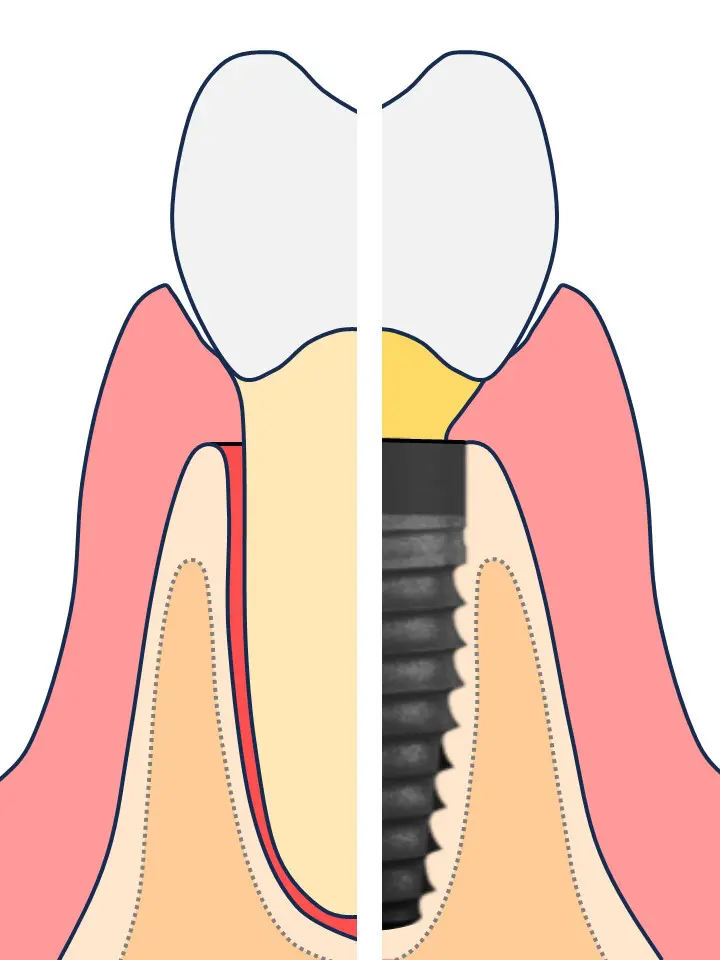
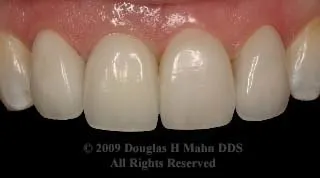
Can you tell which tooth is supported by an implant? Scroll down to see the answer.
No! During implant placement, the area to be treated is completely numb. The patient feels no pain during implant placement.
Patients drive in for their appointments and drive home without requiring any assistance. Typically, patients say, "Was that it?" or "I can't believe I was worried about that." after the appointment was completed.
When the local anesthesia has worn off, patients typically report having little to no discomfort. Most patients only require medicines like Ibuprofen or Tylenol to manage their discomfort that evening.
Can I See More About How Dental Implants Help Replace Teeth
I am glad you asked. Please take a look at the images below.

IP- Implant Platform. This is the top of the implant. It is the part that the tooth is built on.
I- Implant. The implant is the titanium-alloy screw that the bone integrates into.
A- Abutment. This is the part that is attached to the implant. The crown sits on this.
S- Prosthetic Screw. This screw secures the abutment to the implant.
(The implant and components depicted are manufactured by BIOMET 3i. While important differences do exist between dental implant systems, most systems have these basic parts.)
Clinical Example of a "Step by Step" Implant Restoration
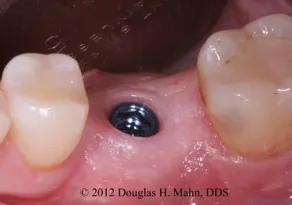
Implant in place. Note the pink and healthy gingiva.
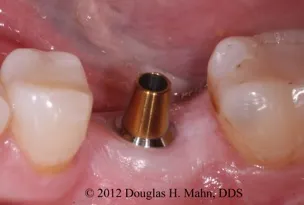
The abutment is secured in place by the screw that was placed in through the hole on top. This hole is then closed with cement. A flat surface on the opposite side (not seen) prevents rotation of the crown.
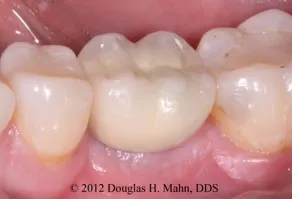
Final crown is cemented on the abutment. (A Cement-Retained Crown)
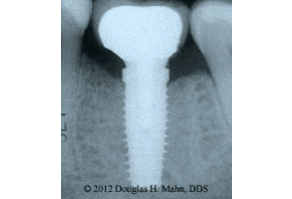
Radiograph of implant, abutment, and crown.

Radiograph with an overlay of implant components.
A Clinical Example of a Highly Esthetic Implant Restoration
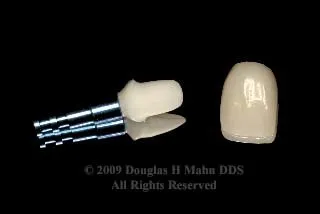
Zirconia is a special metal that is now being used in implant dentistry. It has a useful mix of metallic and ceramic properties. It is used in highly esthetic cases.
The adjacent picture shows a Zirconia abutment on an implant analog. (Analog is used in the laboratory process.) A Ceramic crown sits next to it.

The Zirconia abutment is secured to the implant using a special screw.
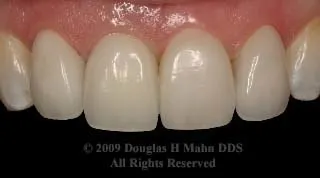
The Ceramic crown is cemented in place.
Case published in Journal of Esthetic and Restorative Dentistry, 2009.
Case published in Journal of Esthetic and Restorative Dentistry, 2009.
A Clinical Example of a "Screw-Retained" Single Crown Implant Restoration
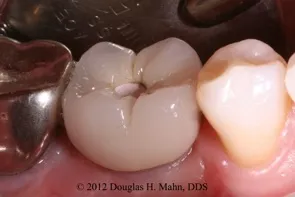
A "Screw-Retained" crown is an alternative to a cement-retained crown. With a screw-retained crown, the abutment and crown are fabricated as one piece. This crown sits directly on the implant. A screw passes through the top of the crown, securing it in place. The screw access hole is closed using a tooth-colored material.
The adjacent picture shows a screw-retained crown before the tooth-colored material is placed.
A Clinical Example of a "Screw-Retained" Full-arch Implant Restoration
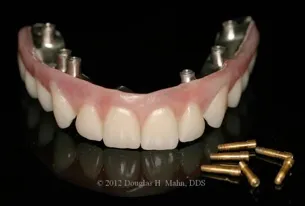
A full-arch screw-retained fixed bridge. The portion that sits on the implants extends above the bridge. The screws are placed through the access holes and secure the bridge to the implants.
The full-arch screw-retained fixed bridge is secured to the implants. Screw access holes (outlined) are covered with tooth-colored material. The bridge is comfortable, fully functional, and natural in appearance.
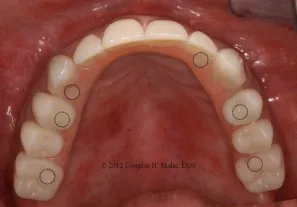
A Comparison of a Tooth Replaced with a "Single Implant vs. Tooth Supported Bridge"
Patients often ask, "Which is better, implants or bridges?" To this I typically respond,
"Let's discuss each form of tooth replacement and see what you decide."
One Tooth Replaced With a Traditional (Tooth Supported) 3-Unit Fixed Bridge:
Summary of Procedure:
Teeth adjacent to the missing tooth are cut into peg shapes. This permits the placement of the bridge. A custom-made bridge is cemented onto the teeth.
Advantages:
- Length of time of treatment may be shorter than implant therapy.
- Short-term costs may be less. May have better insurance coverage.
Disadvantages:
- Two adjacent teeth are prepared (cut) to permit placement of the bridge. These teeth are at risk for problems and may require root canal therapy. It may also require periodontal surgery.
- Requires special hygiene techniques. Floss must be threaded below the bridge. It can be difficult.
- The average bridge lasts about 10 years. Reasons for failure include caries (tooth decay) and root fractures. Re-treatment of supporting teeth may or may not be possible.
- Long-term costs may be greater than implant therapy due to the costs of re-treatment.
- Re-treatment may create cosmetic problems
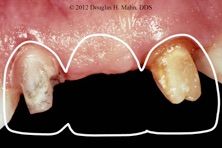
One Tooth Replaced With a Single Implant:
Summary of Procedure:
A dental implant is placed into the jaw bone. The implant is often the size of the original root of the tooth or smaller. A crown is custom-made and secured to the implant. Adjacent teeth are not involved (and, therefore, are protected).
Advantages:
- Adjacent teeth are not involved and not damaged during treatment. This reduces the risk of problems with adjacent teeth.
- Normal hygiene, including normal flossing techniques.
- Implants are not vulnerable to caries (decay) or root canal problems. Implant fractures are rare.
- Implants are among the most successful forms of dental treatment.
- Provided good oral hygiene, treatment can last the entire life of a patient.
- Long-term costs may be less than traditional care.
Disadvantages:
- Short-term costs may be more.
- The length of time of treatment may be greater.
Additional Thoughts
Terms such as "conservative" or "less-invasive" are often used to describe treatments.
The idea of implant "surgery" can be frightening to some patients. Compare this, however, to a tooth-supported bridge, in which multiple teeth are irreversibly cut down into small pegs. Which is truly "conservative" or "less invasive"?
How Do I Get More Information?
There are many resources for more information on dental implants. The website for the American Academy of Periodontology is great. perio.org
At your consultation appointment, Dr. Mahn will be glad to discuss any questions you may have. Dr. Mahn will make sure you have a clear understanding of what will be involved with your care.
You do not need a referral to see Dr. Mahn.
Dr. Mahn would be happy to work with your restorative dentist.
If you do not have one, Dr. Mahn will help you find one.